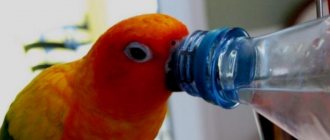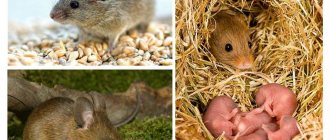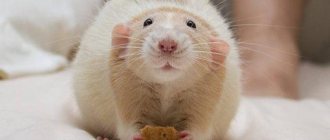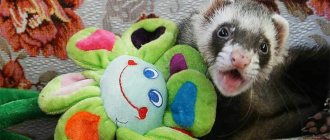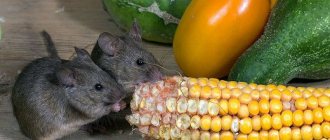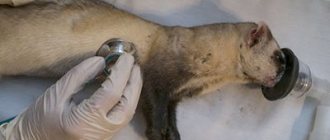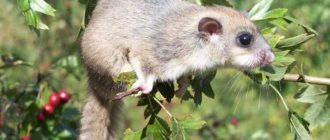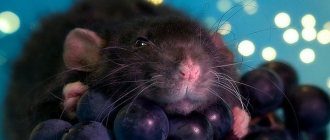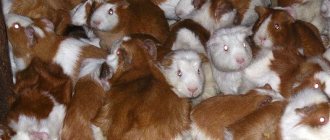The typical representative of the mustelid family is the ferret. They perfectly complement the fauna of the European part of our Motherland, living on forest edges, in the steppes and near large bodies of water. Recently, they are often introduced into homes, because a domestic ferret is a playful and active companion for any family member. However, of no less interest are the wild individuals of the ferret family - predators, aggressive and courageous, who will definitely not allow themselves to be offended.
Appearance
The wild ferret is primarily brown and black in color, with darker tails, paws and muzzle. White fur goes on the forehead, chin and ears. Lighter fur also appears on the sides and belly of the animal. Sometimes you can find other variations of what a ferret looks like - with completely red fur or albino ferrets - these are called furo.
The shiny fur is not thick, but long - on the back it can reach up to 5-6 cm. The fur becomes fluffier after the molting period - in late autumn, and before that it is not so easily soiled and lighter.
The shape of the head is oval, flattened on the sides. The head has a smooth transition line to the neck, flexible and long. Low ears with a wide base stick out on the head. The eyes are small but shiny; most often, brown eyes are found in trochees.
Ferrets have a very slender build. The animals grow from 30 to 50 cm in length. The legs are short (the hind legs are on average only 6-8 cm), but very strong and ideally developed for frequent digging of the ground. The limbs have five fingers with very sharp claws, so if you manage to catch a ferret, it will definitely be able to fend for itself.
Varieties
Stepnoy
The largest of all ferret species. They grow up to 56 cm, and their weight can exceed 2 kg. They are also called light because of the specific undercoat that shows through under the sparse brown hair. The color on the limbs and tail is dark, while the muzzle is painted with a mask.
It is not difficult to say how many years the steppe ferret lives - their age rarely exceeds 10-12 years.
Forest
The color of the forest ferret does not differ in the bright contrast of the color of the body and legs - the black-brown color of the body is complemented by the black color of the limbs and tail. They are inferior in size to their steppe counterparts - 38-48 cm in length, and weight from 500 g to 1.5 kg.
About 14 years is how long forest ferrets live, which is significantly longer than the life expectancy of their domesticated relatives.
Blackfoot (American)
The smallest individuals in the classification - their length rarely reaches 40 cm. Their fur is white at the base and dark at the tips. Overall this gives a picture of a beautiful yellow-brown color. There is a specific mask on the face.
The species is listed in the Red Book, and the life expectancy of black-footed ferrets does not exceed 6-9 years.
Special feed
In pet stores you can buy not only items for feeding ferrets. Nowadays, complete dry food enriched with vitamins and minerals is available for sale.
In order to choose the most suitable food for a particular pet, you can try giving it different types. As a result, it will be possible to determine the most preferable option among all feeds.
When purchasing dry food, you need to carefully study the packaging. It is necessary to completely eliminate any damage, since the food inside may be damp and no longer suitable for consumption.
The composition should not contain a large amount of sunflower seeds. They are high in calories, which is unsafe for health. But the presence of dry vegetables, fruits and grains in the food indicates its good quality.
Habitats
Animal populations were distributed in the following geographical areas:
- Steppe ferrets in eastern Europe (Hungary, Romania, Czech Republic, Slovakia and Ukraine), Central Asia, Russia (from the Ural Mountains to the Far East) and in the eastern regions of China.
- The forest ferret can be found almost everywhere in Eurasia, especially west of the Ural Mountains.
- The central part of North America, namely east of the Rocky Mountains, is where black-footed ferrets live.
Habits and lifestyle
The wild ferret is a predatory animal, which is expressed in its distinctive features - aggressiveness and courage. They will not be intimidated by a confrontation with a larger opponent. Fearlessly taking on a fight is in the order of things for them.
In addition, ferrets are also characterized by ruthlessness towards their prey - by attacking a bird’s nest, the animal will satisfy its hunger and then kill every inhabitant. And all this is said about a ferret - an animal that from the outside can be called very cute.
Ferrets do not form packs, but maintain contact with their closest relatives. Moreover, in these relationships one alpha male dominates, which is more clearly expressed both during normal times and during mating. But each of the individuals has its own territory for living, which they mark by making regular rounds.
The activity of the animal occurs at night. During the day the animal sleeps, having previously dug a hole for itself. The burrow can be permanent - with a small hole and a chamber, or temporary - if movements at dawn find the animal far from home. In this case, these small predators do not shy away from using other people’s holes - hare or badger ones. And when the weather is bad, the ferret can spend several days in the hole without leaving.
Vitamins for pets
Ferrets' nutrition should be complete and balanced. If for any reason the animal lacks vitamins, for example, in winter, when there are no fresh herbs and vegetables, there is a need to saturate and support the small organism with special supplements.
In winter, you can give sprouted grains; they are rich in vitamins. If there are no grains, you should contact a veterinary pharmacy, where you can purchase special vitamin complexes. These can be powders, drops, tablets, granules.
Vitamins presented in the form of granules and rice balls do not have any therapeutic effect; they are used for prevention.
Minerals are also necessary for the normal functioning of the body. Most often, their deficiency is compensated for by adding meat and bone meal to food (about 2 times a week).
Nutrition
Ferrets are exclusively nocturnal animals. Only very strong hunger can force one to interrupt daytime sleep and go hunting during daylight hours.
The following representatives of the animal world become prey, namely what ferrets eat in nature:
- what the ferret eats first of all are small rodents: rats, hamsters, mice, gophers, moles and ground squirrels, hares and rabbits;
- lizards or small amphibious reptiles;
- They easily destroy found egg clutches, and sometimes attack birds.
Animals do not eat plant foods due to their digestive characteristics. However, a ferret can get nutrients from, say, fruit by eating small herbivores. It is also worth noting that in difficult situations, if it is impossible to find anything that ferrets usually eat, they are able to eat the carcasses of already dead animals.
Consequences of improper feeding
Ill-thought-out organization of ferret nutrition can turn into a disaster for the owner and the furo itself. Signs that the selected food is not suitable include:
- stomach upset;
- changes in the color and consistency of feces and urine;
- hair loss;
- lethargy of the pet.
If you notice at least one of the above signs, you should immediately seek help from a veterinarian, otherwise the consequences will not be long in coming. If improper feeding continues, the animal will develop diabetes, gastrointestinal diseases and other pathologies.
Reproduction
The mating period varies depending on the type of ferret: steppe ferrets begin rutting at the end of February, and forest ones - starting in April. Moreover, the rutting period may last until the end of the calendar summer.
Ferrets become mature enough to procreate at 10-12 months of their life. It is not customary for ferrets to have mating games, and the mating itself looks quite cruel: the male suppresses the female’s resistance in every possible way, biting her scruff and withers.
Females carry their offspring for almost a month and a half, and they have 4-12 cubs in a litter. Newborn ferrets are very helpless and are born blind, but development occurs quickly - after only two months of life, the mother begins to feed them meat.
Interesting Facts
- Ferrets, unlike many other mammals, do not have food competition, due to the fact that males are almost twice as large as females and hunt larger prey, leaving small ones for females and young animals;
- In the last decade, many ferrets have died not from hunters, but from the wheels of cars, due to the expansion and increase in the number of highways and roads;
- The ferret's closest relative is the skunk, which lives on another continent.
Enemies
In winter, the main dangers for ferrets are wolves and foxes. An encounter with wild cats, birds of prey (eagles, golden eagles or night owls), as well as large snakes can also become unpleasant.
Among the creatures dangerous to ferrets, humans can also be mentioned. Its impact, namely the destruction of nature reserves, the construction of roads and housing in wild areas, can cause the disruption of the ferret ecosystem and the destruction of their habitats.
Domestication of the ferret
These animals can be domesticated - they are very playful and quickly get used to their owner (especially females). They can be trained to a litter box without any problems, but if the animal likes another place to relieve itself, then another container will need to be added there.
It is worth considering that due to natural influences they will not get along with birds, small rodents or reptiles. However, they are able not only to coexist with cats or non-hunting dogs, but also to be friends.
Curiosity is another important quality of these animals. So, you should prepare for the fact that the animal will regularly and carefully examine all possible nooks and crannies in the house, climb into trash cans (and sometimes fall asleep there), and also dig up soil in flower pots.
There is another point that you can pay attention to - their life expectancy. How long ferrets live at home mainly depends on proper care and maintenance, but on average it is 5-9 years.
Diet features
By nature, ferrets have developed the habit of storing food for future use. Therefore, when observing, you can notice how this nimble animal, instead of eating food, takes it and hides it in the most reliable place. This happens in natural conditions. But there is a need there, because the animal must make sure that there is something to eat during the cold season.
For domestic ferrets, there is no need to stock up, so it is better to give them food in small portions.
It is worth giving food 2 times a day, trying to choose the most correct foods. A ferret's diet should include:
- Grains – millet, oats, seeds, including watermelon.
- Fruits – preferably apples and pears.
- Vegetables - pumpkin, cucumbers, zucchini, tomatoes, bell peppers.
- Dairy products - kefir, always low-fat and without sugar, cottage cheese and natural yogurt.
- Chicken meat is boiled and always lean.
- Boiled fish, cooked without salt or spices.
- Boiled eggs – 2 times a week.
- Berries - currants, strawberries, cherries, cherries, gooseberries, blueberries.
- Insects and beetles, which can be purchased at a specialty store. It is not recommended to give ordinary earthworms, because the animal may become infected.
- Greens – leaves of vegetable crops, sprouts of grain plants.
During the winter season, you need to make sure that your pet receives a sufficient amount of vitamins. Ferrets enjoy eating dried fruits, peas and dried beans.
